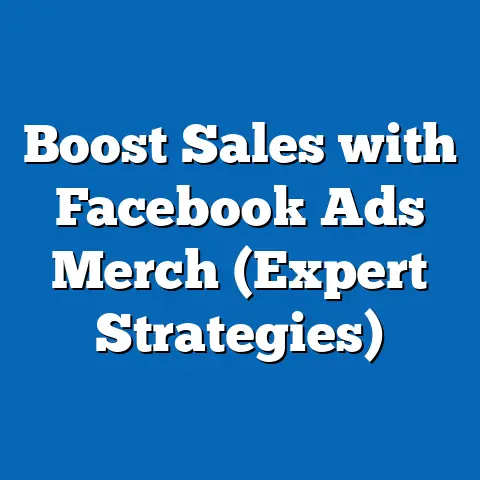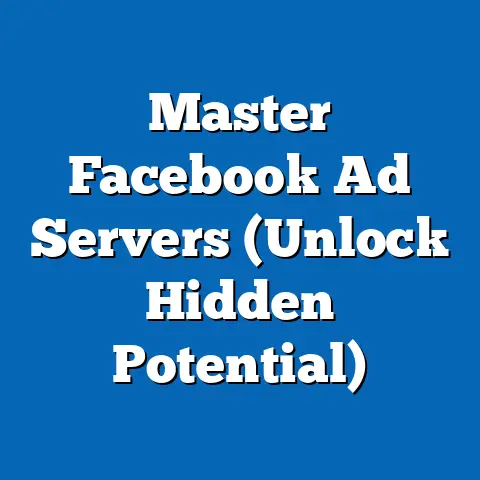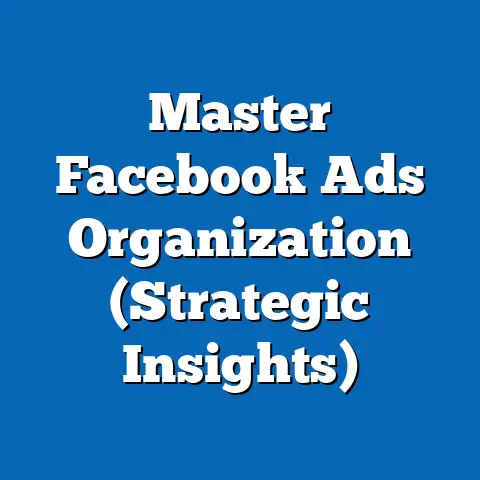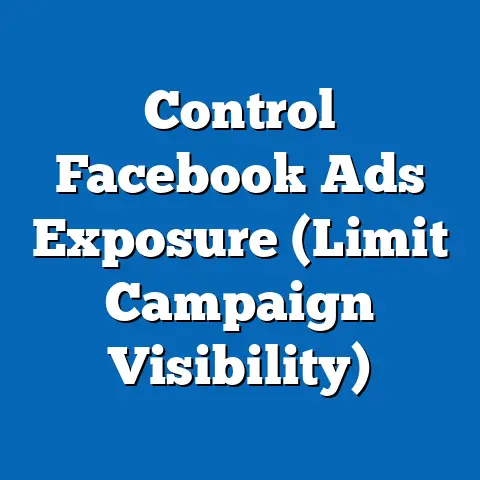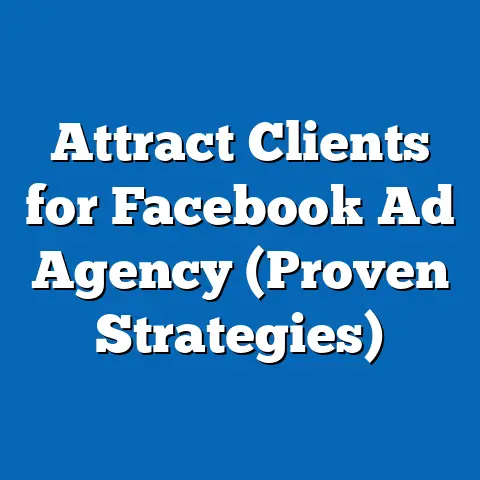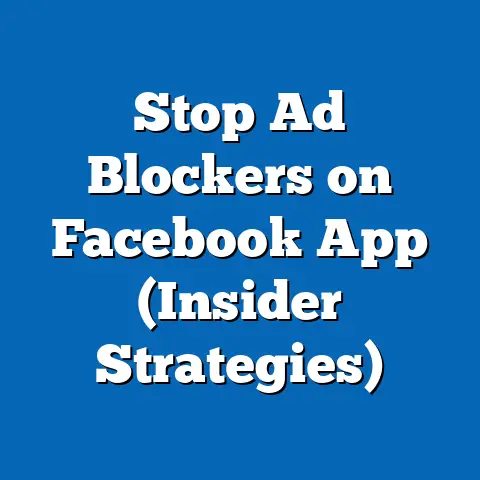Maximize ROI with Facebook Accounts (Proven Strategies)
I’ve seen it happen time and time again. Businesses pour money into Facebook ads, hoping to see a surge in sales or leads, only to be met with… well, not much. It’s a frustrating experience. You’re staring at the Ads Manager, wondering where all that budget went and why your ROI is hovering somewhere near zero. You’re not alone. I know many digital marketers and business owners share this struggle.
Understanding Facebook Advertising
Facebook advertising is a powerful tool that allows businesses to reach a highly targeted audience with tailored messages. It goes beyond simply posting on your business page and hoping your followers see it. Facebook Ads give you control over who sees your content, when they see it, and what action you want them to take.
The Significance of Facebook Advertising
In today’s digital landscape, organic reach on social media is declining. This means that fewer and fewer of your followers are seeing your posts without paid promotion. Facebook advertising provides a solution by allowing you to cut through the noise and reach a wider audience, including potential customers who may not even know your business exists.
The power of Facebook advertising lies in its ability to target specific demographics, interests, and behaviors. This level of precision allows you to deliver your message to the people most likely to be interested in your products or services, maximizing the efficiency of your advertising spend. Think about it: instead of broadcasting your message to everyone, you’re whispering it to the right ears.
Different Types of Facebook Ads
Facebook offers a variety of ad formats to suit different campaign objectives and creative styles. Here’s a breakdown of some of the most common types:
- Image Ads: These are simple yet effective ads featuring a single image and accompanying text. They’re great for showcasing products, promoting events, or driving traffic to your website. I find that high-quality, visually appealing images are key to success with image ads.
- Video Ads: Video ads are highly engaging and can be used to tell stories, demonstrate products, or share testimonials. They are particularly effective for capturing attention in the busy newsfeed. I’ve seen video ads significantly boost engagement and brand awareness.
- Carousel Ads: Carousel ads allow you to display multiple images or videos in a single ad unit. This format is ideal for showcasing a range of products, highlighting different features, or telling a sequential story. I’ve used carousel ads to effectively display different angles and features of a product, leading to higher click-through rates.
- Slideshow Ads: Slideshow ads are a lightweight video format that combines multiple images into a short, engaging video. They’re easy to create and can be a cost-effective alternative to traditional video ads.
- Collection Ads: Collection ads are designed for mobile shopping and feature a main image or video with a selection of related products displayed below. This format provides a seamless shopping experience directly within Facebook.
Navigating the Facebook Ads Manager
The Facebook Ads Manager is your central hub for creating, managing, and analyzing your Facebook ad campaigns. It can seem daunting at first, but once you understand its key components, it becomes an invaluable tool.
Here’s a breakdown of the key areas:
- Campaign Objectives: This is where you define what you want to achieve with your campaign. Options include brand awareness, reach, traffic, engagement, lead generation, app installs, video views, messages, conversions, catalog sales, and store traffic. Choosing the right objective is crucial, as it tells Facebook’s algorithm what to optimize for.
- Audience Targeting: This section allows you to define your target audience based on demographics, interests, behaviors, and custom audiences. This is where you fine-tune who sees your ads.
- Ad Placements: Here, you choose where your ads will appear, such as Facebook, Instagram, Audience Network, and Messenger. You can opt for automatic placements, allowing Facebook to optimize for performance, or manually select specific placements.
- Budgeting: This is where you set your daily or lifetime budget and choose your bidding strategy. Careful budget management is essential for maximizing ROI.
Key Takeaway: Understanding the different types of Facebook ads and how to navigate the Ads Manager is the foundation for successful Facebook advertising. Take the time to explore the platform and familiarize yourself with its features. Practice will make you perfect.
Setting Clear Goals for Your Campaign
Before you even think about creating an ad, it’s crucial to define what you want to achieve. Launching a Facebook ad campaign without clear goals is like setting sail without a destination – you’ll end up wandering aimlessly and wasting resources.
The Importance of Setting Clear Goals
Clear goals provide direction, focus, and a way to measure success. They help you determine the right campaign objective, target audience, and ad creative. Without clear goals, you’ll have no way of knowing if your campaign is actually working.
Think about it this way: if you want to drive more traffic to your website, your campaign objective will be different than if you want to generate leads or increase brand awareness. Your ad creative and targeting will also need to be tailored to your specific goal.
Types of Goals
Here are some common types of goals for Facebook advertising campaigns:
- Brand Awareness: Increase the number of people who are familiar with your brand. This is often measured by reach, impressions, and ad recall lift.
- Reach: Maximize the number of unique people who see your ads. This is useful for reaching a broad audience quickly.
- Traffic: Drive more traffic to your website or landing page. This is measured by clicks, landing page views, and cost per click.
- Engagement: Increase the number of likes, comments, shares, and other interactions with your ads. This is useful for building a community and generating social proof.
- Lead Generation: Collect leads from potential customers through lead forms or other methods. This is measured by the number of leads generated and cost per lead.
- App Installs: Drive more installs of your mobile app. This is measured by the number of app installs and cost per install.
- Video Views: Increase the number of people who watch your video ads. This is measured by video views, video completion rate, and cost per video view.
- Messages: Encourage people to send you messages through Facebook Messenger. This is useful for providing customer support or generating leads through conversations.
- Conversions: Drive more conversions on your website, such as sales, sign-ups, or form submissions. This is measured by the number of conversions and cost per conversion.
- Catalog Sales: Promote products from your online store’s catalog. This is useful for driving sales of specific products or collections.
- Store Traffic: Drive more foot traffic to your physical store location. This is measured by the number of people who visit your store after seeing your ads.
SMART Goals for Facebook Advertising
To ensure your goals are effective, they should be SMART:
- Specific: Clearly define what you want to achieve. Avoid vague goals like “increase sales.” Instead, aim for something like “increase sales of product X by 15%.”
- Measurable: Define how you will track your progress. What metrics will you use to measure success?
- Achievable: Set realistic goals that are within your reach. Don’t set yourself up for failure by aiming too high.
- Relevant: Ensure your goals align with your overall business objectives.
- Time-bound: Set a deadline for achieving your goals. This will create a sense of urgency and help you stay on track.
Examples of SMART Goals:
- “Increase website traffic by 20% within the next month by running a traffic campaign targeting users interested in digital marketing.”
- “Generate 50 leads within the next two weeks by running a lead generation campaign targeting business owners in the tech industry.”
- “Increase sales of product X by 15% within the next quarter by running a conversion campaign targeting existing customers and lookalike audiences.”
Key Takeaway: Setting clear, SMART goals is essential for measuring the success of your Facebook ad campaigns and ensuring you’re getting the best possible ROI. Take the time to define your goals before you start creating ads.
Targeting the Right Audience
One of the biggest advantages of Facebook advertising is its sophisticated targeting capabilities. You can reach a highly specific audience based on their demographics, interests, behaviors, and more. Targeting the right audience is crucial for maximizing ROI, as it ensures your ads are seen by the people most likely to be interested in your products or services.
Facebook’s Targeting Options
Facebook offers a wide range of targeting options, including:
- Demographics: Target users based on age, gender, location, education, relationship status, job title, and more.
- Interests: Target users based on their interests, hobbies, and pages they’ve liked on Facebook.
- Behaviors: Target users based on their online and offline behaviors, such as purchase history, travel habits, and device usage.
- Custom Audiences: Create custom audiences based on your existing customer data, website traffic, or app activity.
- Lookalike Audiences: Expand your reach by targeting users who are similar to your existing customers.
The Power of Lookalike Audiences
Lookalike audiences are a powerful tool for reaching new potential customers. They allow you to target users who share similar characteristics and behaviors with your existing customers, increasing the likelihood that they’ll be interested in your products or services.
To create a lookalike audience, you need to provide Facebook with a source audience, such as your customer list, website traffic, or app activity. Facebook will then analyze the characteristics of this audience and identify other users who share similar traits.
I have personally seen significant improvements in campaign performance by using lookalike audiences. They allow me to reach a wider audience while still maintaining a high level of relevance.
Retargeting Strategies
Retargeting is a strategy that involves showing ads to people who have already interacted with your brand, such as visiting your website, viewing a product page, or adding an item to their cart. This is a highly effective way to re-engage potential customers and drive conversions.
Retargeting works by using the Facebook Pixel, a piece of code that you install on your website. The Pixel tracks the actions of visitors to your website and allows you to create custom audiences based on their behavior.
For example, you can create a retargeting audience of people who visited your website in the past 30 days but didn’t make a purchase. You can then show these users ads featuring the products they viewed or offering a special discount.
Refining Audience Segments
While Facebook’s targeting options are powerful, it’s important to refine your audience segments to ensure you’re reaching the right people. Avoid targeting too broad of an audience, as this can lead to wasted ad spend and lower ROI.
Here are some tips for refining your audience segments:
- Layer Targeting Options: Combine multiple targeting options to narrow down your audience. For example, target users who are interested in digital marketing and also have a job title of “marketing manager.”
- Exclude Specific Audiences: Exclude audiences that are unlikely to be interested in your products or services. For example, exclude users who have already purchased your product.
- Test Different Audience Segments: A/B test different audience segments to see which ones perform best.
Key Takeaway: Targeting the right audience is essential for maximizing ROI with Facebook advertising. Take the time to explore Facebook’s targeting options and refine your audience segments to ensure you’re reaching the people most likely to be interested in your products or services.
Crafting Compelling Ad Creative
No matter how well you target your audience, your ads won’t be effective if your creative isn’t compelling. Eye-catching visuals and persuasive copy are essential for capturing attention and driving engagement.
The Significance of Visuals and Copy
In the fast-paced world of social media, you have only a few seconds to grab someone’s attention. High-quality images and videos are crucial for standing out in the busy newsfeed. Your copy should be concise, engaging, and relevant to your target audience.
Think about it: people are scrolling through their feeds, bombarded with information. Your ad needs to be visually appealing and offer a clear value proposition to make them stop and pay attention.
Tips for Creating High-Quality Images and Videos
- Use High-Resolution Images: Avoid blurry or pixelated images. Use high-resolution images that are clear and visually appealing.
- Choose Relevant Images: Select images that are relevant to your product or service and resonate with your target audience.
- Use Eye-Catching Colors: Use colors that are visually appealing and grab attention.
- Keep Videos Short and Engaging: Keep your videos short and to the point. Aim for videos that are under 30 seconds.
- Add Text Overlays: Add text overlays to your videos to highlight key messages and call-to-actions.
- Use Captions: Add captions to your videos to make them accessible to people who are watching with the sound off.
A/B Testing Ad Creatives
A/B testing, also known as split testing, is the process of testing different versions of your ad creative to see which one performs best. This is a crucial step in optimizing your ad campaigns and maximizing ROI.
To A/B test your ad creatives, create two or more versions of your ad with slight variations, such as different headlines, images, or call-to-actions. Then, run your ads and track the performance of each version. The version that performs best is the winner.
I always recommend A/B testing different ad creatives to see what resonates best with your audience. You might be surprised by the results. For example, I once ran a campaign with two identical ads, except for the headline. One headline was more direct and sales-oriented, while the other was more curiosity-driven. The curiosity-driven headline significantly outperformed the sales-oriented headline, demonstrating the importance of testing different approaches.
Key Takeaway: Compelling ad creative is essential for capturing attention and driving engagement. Invest time in creating high-quality images and videos and A/B test different versions to see what resonates best with your audience.
Optimizing Ad Budget and Bidding Strategies
Effective budget management and bidding strategies are crucial for maximizing ROI with Facebook advertising. You need to allocate your budget wisely and choose the right bidding strategy to achieve your campaign goals.
Budgeting Options
Facebook offers two main budgeting options:
- Daily Budget: Set a daily budget for your ad campaign. Facebook will then attempt to spend this amount each day.
- Lifetime Budget: Set a total budget for your ad campaign. Facebook will then attempt to spend this amount over the entire duration of the campaign.
The best budgeting option depends on your campaign goals and how much control you want over your ad spend.
- Daily budgets are useful for campaigns that run continuously or for campaigns where you want to maintain a consistent ad spend each day.
- Lifetime budgets are useful for campaigns with a specific end date or for campaigns where you want to control the total amount spent.
Bidding Strategies
Facebook offers a variety of bidding strategies, each designed to achieve different campaign goals:
- Cost Per Click (CPC): You pay each time someone clicks on your ad. This is useful for driving traffic to your website.
- Cost Per Impression (CPM): You pay for every 1,000 impressions your ad receives. This is useful for increasing brand awareness.
- Cost Per Action (CPA): You pay when someone takes a specific action, such as making a purchase or submitting a lead form. This is useful for driving conversions.
- Lowest Cost: Facebook automatically bids to get you the lowest possible cost per result. This is a good option for beginners.
- Target Cost: You set a target cost per result, and Facebook will try to achieve that cost. This is useful for campaigns with specific ROI targets.
- Bid Cap: You set a maximum bid amount, and Facebook will never bid higher than that amount. This is useful for controlling your ad spend.
Choosing the right bidding strategy depends on your campaign goals and your level of experience.
- For beginners, the Lowest Cost bidding strategy is a good starting point.
- For campaigns focused on driving traffic, CPC bidding is a good option.
- For campaigns focused on increasing brand awareness, CPM bidding is a good option.
- For campaigns focused on driving conversions, CPA bidding is a good option.
Monitoring Ad Spend
It’s important to monitor your ad spend regularly to ensure you’re not overspending or underspending. Keep an eye on your daily or lifetime budget and adjust your bids as needed.
Here are some tips for monitoring your ad spend:
- Check Your Ads Manager Regularly: Check your Ads Manager at least once a day to monitor your ad spend and performance.
- Set Up Budget Alerts: Set up budget alerts to notify you when your ad spend reaches a certain threshold.
- Adjust Your Bids as Needed: If you’re not getting the results you want, adjust your bids or try a different bidding strategy.
Key Takeaway: Optimizing your ad budget and bidding strategies is crucial for maximizing ROI with Facebook advertising. Choose the right budgeting option and bidding strategy based on your campaign goals, and monitor your ad spend regularly to ensure you’re getting the best possible results.
Analyzing and Measuring Performance
Analyzing and measuring performance is essential for understanding what’s working and what’s not in your Facebook ad campaigns. By tracking key performance indicators (KPIs) and analyzing your data, you can make informed decisions about how to optimize your campaigns and maximize ROI.
Key Performance Indicators (KPIs)
Here are some key performance indicators (KPIs) that marketers should track to measure ROI:
- Click-Through Rate (CTR): The percentage of people who click on your ad after seeing it. A high CTR indicates that your ad is relevant and engaging to your target audience.
- Conversion Rate: The percentage of people who complete a desired action, such as making a purchase or submitting a lead form, after clicking on your ad. A high conversion rate indicates that your landing page is effective and your offer is compelling.
- Cost Per Acquisition (CPA): The cost of acquiring a new customer through your ad campaign. A low CPA indicates that your campaign is efficient and cost-effective.
- Return on Ad Spend (ROAS): The amount of revenue generated for every dollar spent on advertising. A high ROAS indicates that your campaign is generating a significant return on investment.
- Impressions: The number of times your ad is displayed to users.
- Reach: The number of unique users who saw your ad.
- Frequency: The average number of times each user saw your ad.
- Cost Per Click (CPC): The cost of each click on your ad.
- Cost Per Mille (CPM): The cost of 1,000 impressions of your ad.
- Landing Page Views: The number of times people landed on your website after clicking your ad.
Using Facebook Analytics and Ads Manager
Facebook Analytics and Ads Manager provide valuable data and insights into the performance of your ad campaigns.
- Facebook Analytics allows you to track the behavior of users on your website and app, providing insights into their demographics, interests, and actions. This data can be used to improve your targeting and ad creative.
- Ads Manager provides detailed data on the performance of your ad campaigns, including impressions, reach, clicks, conversions, and cost per result. This data can be used to optimize your campaigns and maximize ROI.
Interpreting Data
Interpreting data is crucial for making informed decisions about how to optimize your ad campaigns. Look for trends and patterns in your data to identify what’s working and what’s not.
Here are some tips for interpreting data:
- Compare Performance Over Time: Compare your campaign performance over time to see if your results are improving or declining.
- Segment Your Data: Segment your data by demographics, interests, and behaviors to identify which segments are performing best.
- Identify Areas for Improvement: Look for areas where your campaign performance is lagging and identify ways to improve it.
Key Takeaway: Analyzing and measuring performance is essential for maximizing ROI with Facebook advertising. Track key performance indicators, use Facebook Analytics and Ads Manager to analyze your data, and interpret your data to make informed decisions about how to optimize your campaigns.
Advanced Strategies for Maximum ROI
Once you’ve mastered the basics of Facebook advertising, you can start exploring advanced strategies to further maximize your ROI.
Funnel Marketing
Funnel marketing is a strategy that involves guiding potential customers through a series of stages, from awareness to consideration to conversion. This approach allows you to nurture leads and build relationships with potential customers over time, increasing the likelihood that they’ll eventually make a purchase.
A typical funnel marketing strategy for Facebook advertising might involve the following stages:
- Awareness: Create ads that introduce your brand and products to a broad audience.
- Consideration: Create ads that showcase the benefits of your products and encourage potential customers to learn more.
- Conversion: Create ads that offer special discounts or incentives to encourage potential customers to make a purchase.
Customer Journey Mapping
Customer journey mapping is the process of mapping out the steps that a customer takes when interacting with your brand. This can help you identify pain points and opportunities to improve the customer experience.
By understanding the customer journey, you can create more targeted and relevant ads that resonate with potential customers at each stage of the journey.
Integrating Facebook Ads with Other Marketing Channels
Integrating Facebook ads with other marketing channels, such as email marketing, content marketing, and search engine optimization (SEO), can help you create a more cohesive and effective marketing strategy.
For example, you can use Facebook ads to drive traffic to your website and then use email marketing to nurture those leads and encourage them to make a purchase. You can also use content marketing to create valuable content that attracts potential customers and then use Facebook ads to promote that content.
The Role of Facebook Pixel
The Facebook Pixel is a piece of code that you install on your website. It tracks the actions of visitors to your website and allows you to create custom audiences based on their behavior.
The Facebook Pixel is essential for tracking conversions and optimizing ad campaigns. It allows you to see which ads are driving the most conversions and to create retargeting audiences of people who have visited your website but haven’t made a purchase.
Case Studies
Many businesses have successfully maximized their ROI using innovative Facebook advertising strategies.
One example is a clothing retailer that used Facebook ads to target users interested in fashion and style. The retailer created a series of ads featuring high-quality images of their clothing and offering special discounts to new customers. The campaign resulted in a significant increase in sales and brand awareness.
Another example is a software company that used Facebook ads to generate leads. The company created a lead generation campaign targeting business owners and marketing professionals. The campaign resulted in a large number of high-quality leads.
Key Takeaway: Exploring advanced strategies such as funnel marketing, customer journey mapping, integrating Facebook ads with other marketing channels, and using the Facebook Pixel can help you further maximize your ROI with Facebook advertising.
Conclusion
Maximizing ROI with Facebook ads isn’t a matter of luck; it’s a strategic process that requires a deep understanding of the platform, a clear vision of your goals, and a commitment to continuous optimization. I’ve seen firsthand how powerful Facebook advertising can be when approached with the right mindset and techniques.
Throughout this guide, I’ve outlined proven strategies that can help you turn your Facebook advertising efforts into a profitable venture. From setting clear goals and targeting the right audience to crafting compelling ad creative and optimizing your budget, each step plays a crucial role in achieving a positive ROI.
I encourage you to take action and implement these strategies in your own Facebook advertising campaigns. Don’t be afraid to experiment, test different approaches, and learn from your results. The world of digital marketing is constantly evolving, so it’s essential to stay updated on the latest trends and best practices.
Remember, success with Facebook advertising doesn’t happen overnight. It requires patience, persistence, and a willingness to adapt. But with the right strategies and a data-driven approach, you can unlock the full potential of Facebook and achieve significant growth and success in your advertising efforts. So, go out there, create compelling ads, target the right audience, and watch your ROI soar!

